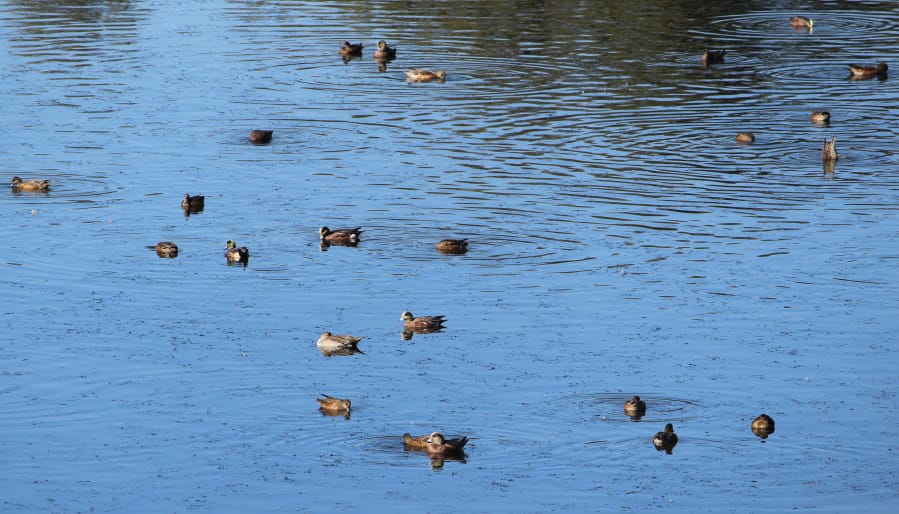In the pre-dawn light, a small flight of ducks swung in over the decoys, presenting themselves perfectly for a shot.
Too bad shooting hours had not started. Once they did the birds vanished.
Under an unclouded bluebird sky we hunted all morning, and all we got were a few passing shots at low-flying geese. The weather forecast had called for clouds, cold, and brisk north winds. None of that materialized.
“I don’t think I’ve ever seen it this slow at Ridgefield,” said my host for the day, Bob Taylor of the Washington Waterfowl Association.
We were hunting on the Ridgefield National Wildlife Refuge’s River S Unit.
While there is nothing unusual about poor waterfowling on bright, sunny days, what is unusual is the pattern this fall of so many such bluebird days. A lack of rain and storms has the majority of northern ducks and geese still hanging around up in Canada.
Waterfowl hunters are left wondering when, or if, conditions will improve.
Ridgefield waterfowling
Eric Anderson, the deputy refuge project leader at the Ridgefield NWR, reports that hunters have struggled for much of this hunting season.
“The season started as most seasons do: there was pretty good hunting during the opening hunt,” said Anderson. “Then it trailed off after the first week. We had those bluebird days for a few weeks, and the numbers dipped.”
“We’ve had a couple pushes of northern birds, mostly pintail” said Anderson, “but not in entirety. There are more to come.”
A quick look at the harvest reports spells it out neatly. The opening day saw a very typical 2.2 ducks per hunter on the refuge, but that figure dropped to 0.6 during the second week.
Since then hunting has followed a consistent pattern of getting better when the rains move in, and dropping off under clear skies.
For instance, from Nov. 5-11, with wet weather, the ducks per hunter climbed to a respectable 1.9.
And again, under sunny skies, our hunt on Nov. 29 was typical of a day that saw hunters take only 0.8 birds per hunter refuge-wide.
What hasn’t been typical is the blinds that have produced the best. Some of the most popular and usually successful blinds on the refuge have under-performed. My hosts on that recent hunt had chosen blind number 19 because it usually produces well for both ducks and geese.
Our lack of success there has been typical of the blind this year, and hunters during the preceding hunt got skunked, too.
Goose hunting has been fair on the refuge, although like the ducks the success has been better on the nasty days.
The refuge operates on a reservation system, and those lacking reservations can fill in any empty blinds through a lottery. All hunters must shoot from an assigned blind. Non-toxic shot is required.
Goose hunters on the refuge must possess a permit for the Goose Permit Zone, and a Southwest Washington Goose Harvest Card. Special rules and shooting hours apply for the goose hunts, which can be found in the Washington Game Bird Regulations.
The season is closed for the endangered dusky Canada goose.
For information on the refuge hunts, visit the Ridgefield NWR website at: https://www.fws.gov/refuge/Ridgefield/visit/waterfowl_hunting.html
Shillapoo State Wildlife Area
Further south, on the Shillapoo State Wildlife Area, the action has been slow for ducks as well, but better for dark goose. Darren Hauswald, the manager of the wildlife area, said that the dry weather has reduced duck habitat.
“It’s been pretty slow, as dry as it’s been,” he said. “It’s the driest I’ve seen it since I’ve been here at the wildlife area.”
He expects the hunting to stay about the same until conditions improve. And, that means rain. Many of the wildlife area’s pools are still dry. There are pumps to move water in, but the Columbia River is too low to allow much pumping.
“We can only run the pumps intermittently,” he said. “The Columbia is at September levels.”
Hauswald did mention that there are a couple pools in the Vancouver Lake Unit with good water, and he has heard reports of duck hunters on the lake itself doing okay.
Goose hunting has been pretty good on the wildlife area.
“One group of ten guys all had their limits,” he reported. “They had set about 200 decoys out in a corn field.”
Shillapoo operates on a first-come, first-served basis, with no reservations necessary.
Sauvie Island Wildlife Area
Hunting has been a little more consistent across the river in Oregon. Hunters targeting the Sauvie Island Wildlife Area have had success rates up to 3 birds per hunter on good days.
For instance, the wildlife area produced 2.2 birds per hunter on Nov. 28, the day before our hunt got skunked.
Whether the skies fill with northern ducks anytime soon will be dependent on the arrival of more typical winter weather. There is no guarantee that will happen, and that leaves local waterfowlers on hold.
At least for now.




